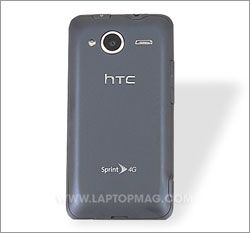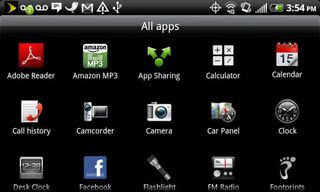Laptop Mag Verdict
Sprint's most affordable 4G phone yet packs a good physical keyboard and smart software into a compact design.
Pros
- +
Attractive blue design
- +
Intuitive and useful HTC Sense software
- +
Spacious backlit keyboard
- +
Fast camera with 720p video recording
- +
Fast 4G and 3G speeds
Cons
- -
Power button difficult to access
- -
A bit thick
- -
No HDMI or front-facing camera
Why you can trust Laptop Mag
Even several months after the Evo 4G's introduction, the flagship Android phone for Sprint continues to ring up sales. But not everyone wants to tote a large handset with a 4.3-inch display. Enter the $149 Evo Shift 4G, a little brother to the Evo with a 3.6-inch screen and slide-out keyboard that's $50 cheaper. What you give up--other than screen size--is a front-facing camera, faster processor, and HDMI output. Those sound like pretty reasonable trade-offs to us. But does the Shift 4G really deliver the value it promises?
Design
Those sick of black slab phones are in for a treat. The Evo Shift 4G sports a classy midnight blue design, and the nice soft-touch finish on the back reminded us of the T-Mobile G2. This treatment carries over to the area surrounding the keyboard. Four circular backlit buttons--Home, Menu, Back, Search--sit beneath a 3.6-inch display (800 x 480 pixels). The screen is clear and bright when viewed straight-on, but the picture washed out from the sides.
While we don't usually focus on the location of the power button, in this case it's an issue. It resides on top of the Shift 4G on a downward slope, which makes it difficult to access. After a while, you'll learn to find this button by feel, but given that Android has a lock screen, it's an unnecessary obstacle. The left side of the Shift 4G houses an easier-to-access volume rocker, and the headphone jack is also up top.

Click to enlargeMeasuring 4.6 x 2.3 x 0.6 inches, the Shift 4G is more compact than the Evo 4G (4.8 x 2.6 x 0.5), making it an easier fit for smaller hands. On the other hand, the Shift 4G is thicker than the Evo and almost as heavy (5.8 ounces vs. 6 ounces), so you'll definitely want to think hard about that physical QWERTY.
Keyboard
The Shift 4G's keyboard slides out smoothly without feeling too loose. Overall, HTC did a pretty good job here. There's plenty of space between the keys, they're nicely backlit, and we like the easily identifiable Fn key. We also appreciate the large space key and dedicated @ key. HTC even includes a shortcut for choosing different emoticons. We just wish HTC made .com its own key instead of a function key combo.
In our testing, the Shift 4G's keyboard proved accurate so long as we used the very tips of our thumbs. While flat, the keys on this handset didn't feel as stiff as the Droid 2's keyboard or as gummy as the QWERTY on the T-Mobile G2. However, we could type much more quickly with the touchscreen keyboard in landscape mode.
The real benefit of using the physical QWERTY on Android is that you can see more content on the screen when typing. You also don't have to worry about the software guessing a word you didn't mean to type. Plus, you can easily make fine cursor movements with the small D-pad to the right of the layout, which worked well.

Click to enlarge
Software and Apps
Powered by Android 2.2, the Shift 4G has HTC's Sense interface. You get seven home screens populated by various HTC widgets, including Favorites (the people you contact most), switches for the wireless radios, a music player, web bookmarks, and FriendStream for quickly reviewing the latest social networking updates from Facebook, Flickr, and Twitter in one place. You can also post one update to all these services at once. As with other Sense-enabled phones, performing a pinch gesture on the home screen lets you see thumbnails of all seven screens at once.

Click to enlarge
First-time smart phone users could easily excuse the clock on the main home screen as mere decoration, but if you touch it you can set the alarm, use a stopwatch, and more. Touching the weather icon beneath the time on the main screen provides a five-day forecast. Sense software does some other neat tricks. For example, when a Facebook friend calls, you'll see his or her latest status update.
Sprint bundles a bunch of useful apps, such as Amazon Kindle for reading eBooks, Amazon MP3, and QuickOffice. Pre-loaded apps from Sprint include Nascar, Sprint Football, Sprint TV, and TeleNav GPS (which you won't need because of the free Google Navigation). All the usual Google suspects are here, too: Gmail, Maps, Search, Talk, YouTube, etc.
Specs and Performance

Click to enlargeA step down from the 1-GHz processors on the highest-end phones, the Shift 4G has 2GB of ROM, 512MB of RAM, and a 800-MHz Qualcomm MSM7360 running Android 2.2. This is the same chip that's inside the T-Mobile G2, though Sprint's phone trailed the G2 in some benchmarks.
For instance, in Fps2D, which measures frame rates, the Shift 4G scored 54 to the G2's 57. In the Benchmark program, the Shift 4G trailed the G2 in the Graphics and CPU portions of the test, but turned in better memory and file system scores.
Overall, the Shift 4G was responsive during our tests, but we could tell that the Sense software was taking up some system resources. The G2 is a bit swifter because it has a more "pure" load of Google's OS.
On the memory front, the Shift 4G ships with just a 2GB microSD card, but you can expand that capacity to 32GB. Too bad the slot is located behind the battery.
Web Browsing and 4G

Click to enlargeNow that Sprint 4G is available in 71 markets in the U.S., we have no qualms with the $10 premium data charge Sprint tacks onto its $69 Simply Everything Plan. That plan includes 450 voice minutes, unlimited 4G data, and 5GB on 3G. In New York City, it took 15 seconds for the 4G radio to activate, and a total of 40 seconds for the device to connect. When we fired up the Speedtest app on the Shift 4G in New York City, the phone notched between 6.7 Mbps and 9.4 Mbps, which is excellent. Mobile sites such as CNN.com and NYTimes.com took between 3 and 5 seconds to load, and the full version of Laptopmag.com loaded in 14 seconds. Over 3G, the above sites loaded in between 6 and 7 seconds, and Laptopmag.com took 24 seconds. These speeds are faster than what we've seen from the myTouch 4G and T-Mobile G2, which ride on the carrier's HSPA+ network.
The Shift 4G can also be used as a mobile hotspot for up to eight devices, just like the pricier Evo. Getting connected was a cinch using our ThinkPad T410s, and we saw brisk uploads over 3G ranging from 900 Kbps to 1 Mbps. Downloads were much slower, from 110 to 490 Kbps. Over 4G the Shift kicked throughput up to nearly 6 Mbps on the download and consistently delivered 900 Kbps to 1 Mbps uploads.
Camera and Camcorder
Equipped with a 5-megapixel camera, the Shift 4G snaps photos quickly and includes a ton of settings. You'll find sliding controls for brightness, contrast, saturation, and sharpness, a sliding zoom control, and several effects, from Grayscale to Posterize. You can also tweak the ISO, white balance, and toggle auto focus and face detection.
On our tests, the handset took colorful shots that were just a bit fuzzy, such as when we snapped a photo of a New York City newsstand. The Shift 4G includes an LED flash that worked well indoors; it added some light without blowing out the subject. Users can share images using Facebook, E-mail, Twitter, and more.

Click to enlarge
Those who like to shoot and share video will be pleased with the Shift 4G. It captured quality 720p footage of a couple of cars driving by in midtown Manhattan, and the sound was plenty loud when we played back the footage on a big-screen monitor. Unlike the Evo 4G, you don't get HDMI output for playing content on a TV, but we can live with that omission.
Entertainment
In addition to YouTube, Shift 4G owners can choose from a decent array of entertainment apps, including Amazon MP3 and Kindle, as well as Sprint TV. When we tried streaming some ESPN highlights over 4G, playback was mostly smooth but the audio sounded tinny. An NBC News update only filled up half the screen, and over 3G we noticed severe skipping. The Shift 4G's small speaker on the back was plenty loud for listening to tunes in a small room. Want to kick it old school? The Shift 4G also includes an FM radio, which was able to pick up plenty of stations in NYC. We could hear some static, but it wasn't overly distracting.

Click to enlarge
Call Quality and Battery Life
Calls made with the Shift 4G were mostly clear, so long as we kept our ear directly on the receiver. The sweet spot seems somewhat narrow. Other callers said there was only a little fuzziness on the line.

Click to enlargeOn our battery rundown test (continuous web surfing over 4G), the Shift 4G's 1500mAh battery lasted 6 hours and 51 minutes. That runtime is a half hour better than the Evo 4G, which has a larger display, and nearly a half hour better than the Android phone average. Still, both the Droid X (7:44) and Droid 2 (6:57) lasted longer.
Verdict
For $149, the Shift 4G is a reasonably priced 4G smart phone that gives Sprint customers a physical keyboard option. Plus, it's more affordable than the Samsung Epic 4G and Evo 4G, both of which are $199. We prefer the keyboard and the brighter and bigger Super AMOLED display on the Epic 4G, but the Shift 4G lasts more than an hour longer on a charge. Overall, the Shift 4G is a solid pick for what you're paying. It offers faster web speeds than the T-Mobile G2 and Motorola Droid 2 and a good typing experience.
HTC Evo Shift 4G (Sprint) Specs
| Bluetooth Type | Bluetooth 2.1 EDR |
| Brand | HTC |
| CPU | 800-MHz Qualcomm MSM7630 |
| Camera Resolution | 5 MP |
| Carrier | Sprint |
| Company Website | http://www.sprint.com |
| Data | EV-DO Rev. A, Mobile WiMAX |
| Display (main) | 3.6 inches/800 x 480 |
| FM Radio | Yes |
| Form Factor | QWERTY Slider |
| GPS | Yes |
| Memory Expansion Type | MicroSD/SDHC |
| Operating System | Android 2.2 |
| RAM | 512MB |
| Size | 4.6 x 2.3 x 0.6 inches |
| Talk / Standby Time | 6 hours |
| Weight | 5.9 ounces |
| Wi-Fi | 802.11b/g/n |

Most Popular

